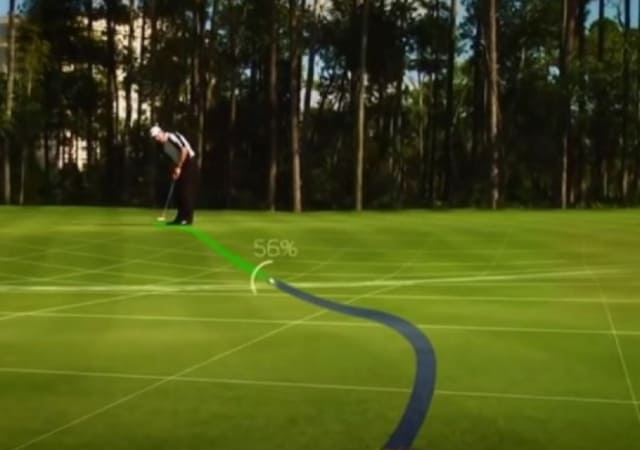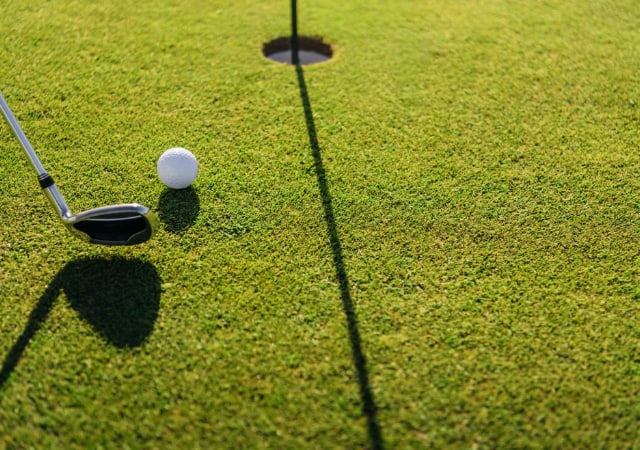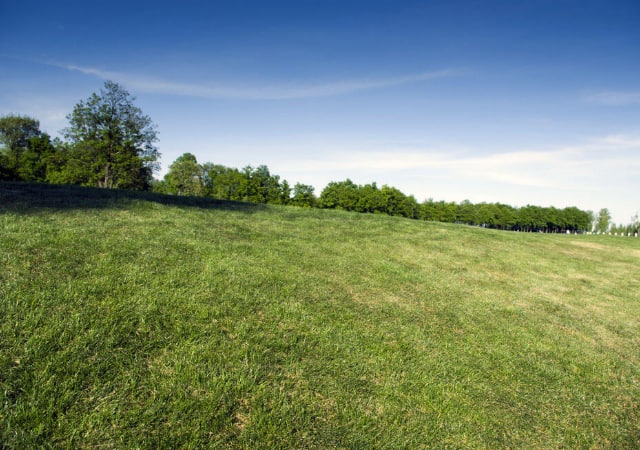From a layman’s view, golf looks as simple as putting a ball in the hole with a stick, but this game needs proper learning and practice. There are techniques and tactics to become a better golfer.
Reading Greens in the course is mandatory for an accurate shot. This is one of the reasons for making more putts every time. A better reading of the greens before swinging your club guarantees a great shot.
However, reading greens is not as simple as it looks. It takes a lot of time and practice.
Read on to learn some tips to accurately read greens, provided by our team of experienced golfers.
- 1) Importance of Reading Greens
- 2) Effect of Grass on Your Game
-
3)
14 Tips To Make More Putts Every Time
- 3.1) #1 Through Meditation
- 3.2) #2 Pay Attention to The Little Details
- 3.3) #3 Make it a Routine
- 3.4) #4 Indecision is The Worst Habit
- 3.5) #5 Breaking Putt Reading – The Ball’s Final Turn Towards The Hole
- 3.6) #6 Watch Your Partners Play
- 3.7) #7 Consider Wind Direction
- 3.8) #8 Right Speed is Necessary
- 3.9) #9 The Aimpoint Method
- 3.10) #10 Reading From Behind the Hole
- 3.11) #11 Looking At The Grass
- 3.12) #12 Shades Of The Grains
- 3.13) #13 Work On Your Focus
- 3.14) #14 Plumb Bobbing
- 3.15) #15 Ask For Another Perspective
- 3.16) #16 Look out For hazards
- 4) Final Thoughts
Importance of Reading Greens
If you want to master the art of putting, you should spend time learning how to read greens because your number of putts depends heavily on the condition of the grass and slope. In addition, learning about the grass condition helps you know what kind of putting surface you will be playing on.
A perfect green is a surface with a few bumps, which makes it so interesting to play on. The grass is a little firm, and it helps you roll the ball very easily. Completely dried grass is only an ideal condition. It usually can’t be achieved since greens are under open sky. A little rain can influence the putts to roll slower.
Effect of Grass on Your Game

You may not realize that the grass around the green can affect your score. Many factors determine the quality of the grass. For example, rain will make the grass thicker and shinier. Some kinds of fertilizers also affect the grass. This may cause it to grow longer and thicker.
When the grass is too thick, it becomes harder to control the ball. You’ll trap more grass in the rough which eventually causes fewer divots. It will also cause the swing to get slower and affect the distance the ball will cover. You might end up with a miss-hit.
The thickness of the grass will also change according to the weather. For example, dry summer affects the grass and makes it difficult to hit a shot (as grass sometimes grabs the clubhead and causes mishits, fat shots, or any type of ugly shots).
Even though courses tend to use types of grass that withstand heat (like Bermuda grass) and sprinkler systems to keep them fresh, any golfer you ask will tell you how difficult it is to constantly make good shots during the summer heat. It is therefore essential to learn how to read the condition of the grass and which techniques to use to avoid mishits.
14 Tips To Make More Putts Every Time
The greens on a golf course are essential. When they get close enough, golfers must always start to read the green to help with their shot.
If you know how to read the greens, you will have a better chance of making putts. A putt is one of the most challenging shots that you can make. This is because you are required to estimate the distance of the putt and the speed of the ball.
Here are some tips for reading greens effectively:
#1 Through Meditation
To be successful in golf, you must learn how to be in a state of complete concentration. You can achieve this through meditation, the practice of focusing your mind on one point.
Many golfers, including Tiger Woods, practice meditation and mindfulness to improve their performance. He visualizes the path the golf ball will take and plays the shot needed. You can meditate by simply closing your eyes, concentrating on your breathing, or using your visualization skills.
Watch this video (from 3:08 to 4:01) for a sneak peek into the exercise.
#2 Pay Attention to The Little Details
Having a look around is an integral part of reading greens and deciding which techniques to use so as to make a good shot.
If you notice the grass is thin or dry (or both), then your shot and ball will go faster, which calls for a bit slower stroke. On the other hand, if the grass is thick or wet (or both), the speed of the ball and its roll will be reduced, in which case you should swing a bit faster than you normally would.
Furthermore, you need to pay attention to the ground around the hole and green (while approaching). If the turf looks flat, then things are looking up, and putting won’t be overly complicated (than it already is).
However, if you notice any undulations, then you should expect uneven ground and slope on the putting green. In this case, you should take the slope direction (and breaking point – discussed later) into consideration and modify your swing speed accordingly.
#3 Make it a Routine
A great putting routine will help you to play golf better. It would be best if you made your routines as easy as possible. The first thing when golfers enter the course is usually loosen up at the practice range. After that, They go over to the practice green and hit some practice putts.
The next step is to read the greens. It helps them to be aware of what’s happening around.
As time goes on, your routine will be engraved into your long-term memory, meaning that, at one point, you will be able to read greens, pay attention to the details and make the right decisions for different shots without giving it too much thought.
#4 Indecision is The Worst Habit
To avoid mistakes and indecision, commit to your line before your putt. Once you make that decision, you should stay with that plan. Before your putt, you should consider what line you will putt your ball on and what kind of stroke you will use. You can even practice these shots. It will take a little while to get better at putting, but once you do, you will become a master of your game.
#5 Breaking Putt Reading – The Ball’s Final Turn Towards The Hole

Sometimes we miss a long putt because we just focus too much on the hole. That’s why we should pay attention to what happens during the putt. That way, you will be more confident about putting, and your long putts will be more accurate.
When you are putting, you should try to maintain your focus on the breaking point (the moment the ball turns towards the hole), and make sure that you don’t move your gaze from that point because if you fail to hit the break point, the ball will deviate from your designated path, and the hole will be missed.
Focusing on the breaking putt point is especially useful in case of slope, when it’s not possible to putt into the front of the hole, but more to one of its sides. You should be able to designate the exact point at which the ball will stop going straight and deviate to the left or right to enter the side of the hole.
With enough practice, knowing the exact breaking putt point will be much easier, and you’ll get more putts and better scores as a result.
#6 Watch Your Partners Play
Besides being interesting, watching others play will help you improve your putting skills. By seeing how they putt, you will be able to understand how the ball reacts to the greens.
Upon entering the golf course, you will be able to distinguish amateurs and beginners from seasoned or even professional players just by their attitude. Amateur golfers would, while waiting for their turn, usually indulge themselves in small talk with other golfers. In contrast, a pro golfer would spend every moment before their turn observing the others playing their game.

#7 Consider Wind Direction
When playing Golf, wind direction should be considered before taking your shot. When you hit your ball, you will want to know where the wind is blowing. For instance, in case of side winds, you should aim in the opposite direction, and the wind will correct the trajectory of the ball. You can practice it on a golf simulator, which has options for simulating weather changes and even a virtual windy course.
It will be a good idea to hit several balls into the wind to see how much the wind affects your shots. Then, when you practice, make sure you are facing the wind. Otherwise, you won’t be able to learn how to control your shot.
#8 Right Speed is Necessary
Since putts can be anywhere from downhill, uphill, or an amalgamation of both, you need to read multiple times from different points to get an idea about the ups and downs of a putt and increase or decrease your speed as needed.
If you read it as a flat putt, you have to hit your ball at an average pace. Then, it will take the ball directly to the hole.
For a downhill putt, you need to have a speed cut. You should imagine a point before the hole to hit the ball. The slope will do the rest (take the ball to the hole).
Uphill shots are the hardest ones. The slope might hinder your ball from reaching the hole, but there’s a trick. Imagine a spot some paces beyond the hole and hit a bit harder. Your ball probably will land in the hole.
#9 The Aimpoint Method

The Aimpoint method is one of the favorite techniques of pro golfers to read the greens. Better players like Adam Scott, Justin Rose, Dustin Johnson, and Lydia Ko use their feet to observe the percentage of slopes of a targeted putt. An interesting fact about this method is that it even allows an average player to read the greens like a pro.
To read the greens through the Aimpoint method, you have to reach the midpoint of the putt. Next, use your feet to determine the slope percentage, and finally, use your fingers (as can be seen in the video below) to complete the method.
Lydia Ko, a famous pro golfer, explains the aimpoint method in this video (4 minutes and 37 seconds).
Only the practice of reading greens by using your feet makes your brain recognize the undulations at the course.
#10 Reading From Behind the Hole

This is a vital tip in reading greens; from behind the hole. In this way, you can watch the path the ball takes. It would be best if you looked for even the slightest of the slopes since it can affect the ball speed. Inspect the area near the hole for any undulations; those are usually indicators of slope (and additional calculations needed to make the harder putt).
#11 Looking At The Grass
It is important to note the grass type. The grass blades’ direction sometimes obstructs the ball’s smooth path if the ball is moving in the opposite direction. In this case, the swing needs to be a bit harder. With that, the regular grass can have no or low loss of speed, but the Bermuda grass can be highly resistant to the ball path.
#12 Shades Of The Grains
Grain reading has a crucial role in the overall reading of the greens in golf. You can read the grains by considering the color changes in the grass. Golfers usually have purpose-specific glasses.
If you notice a darker shade on a patch, it might mean that the putt is slower and into the grain. This is because the direction of the grass is toward you.
Your shot will be faster than usual if the putt and the grass directions are the same. The grass there would have a shiny look and be lighter in color.
When you are down the grain and have to land the ball uphill after crossing the undulations, the shot may (and probably will) be very difficult because you might be blind to the grass color near the hole.
Here is a video (2 minutes and 51 seconds) to help you with your grain reading:
#13 Work On Your Focus
When you’re putting, you need to have confidence and focus. It doesn’t matter whether you are practicing alone or with someone else. Even if you are struggling, you shouldn’t let your thoughts distract you. There are lots of factors that can cause you to fail while you are trying to putt.
While putting, keep your focus solely on the ball. Your emphasis should be on ensuring that the putter hits the ball properly and gets it to the cup. It would help if you focused on the movement of the ball. If you do this correctly, you should have a high chance of making a putt.
#14 Plumb Bobbing
Plumb bobbing involves testing the slope of a green by using a weighted plumb bob. It is the practice of hanging the club in front of your eyes with a straight arm to try to read your putt while keeping the club steady (with the ball between you and the hole).
The club will form a line with the hole if you close one eye. The putter head will lean to the direction where the ball is going to break, giving you an idea where your aim should be. Once the golfer has a general idea of what kind of slope the green has, they finalize their reading of the greens.
Although it’s a controversial practice in Golf, It can help you to feel confident on the green. One of the PGA Tour’s players, Ben Crenshaw, has used this technique as well.
A video of ( 1 minute 28 seconds) might help you in better understanding of plumb bobbing:
#15 Ask For Another Perspective
It would be best if you also asked your friend or a coach to read the greens with you. This can help you to improve your skills and make reading greens easier.
Your friends and coaches will be able to spot mistakes that you make. Then, you can ask them to correct your errors as you read the greens. This way, you will be able to learn and get better.
#16 Look out For hazards

When you are reading the greens, you should be looking out for bunkers. These are found all over the course and sometimes around the green and could cause problems. Hazards must be avoided because they are tough to handle.
Also, you should be looking out for water hazards like lakes or rivers. If you are unsure whether an obstacle is a bunker or a water hazard, check the golf course yardage book; it can help you identify it.
Be ready for any hazard that you may encounter on the course. Always try to anticipate what could happen and be prepared for anything. If you find a hazard and are unsure how to avoid it, try to go around it.
Final Thoughts
Greens are one of the most critical aspects of the game of Golf. To improve your putting, you should try to learn how to read greens. You should practice your skills from time to time. Practice makes perfect, and you should practice it over and over again until you have it down pat.
Golf requires constant practice and improvement. These are some excellent tips to keep in mind. They can help you achieve your dream of becoming a better Golfer. How often you should play golf to improve your game is another crucial factor in your development. Consistent practice and application of these green-reading techniques will significantly enhance your putting skills over time





